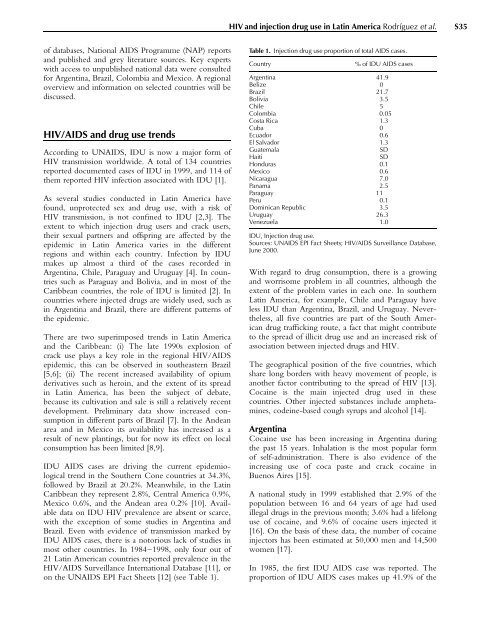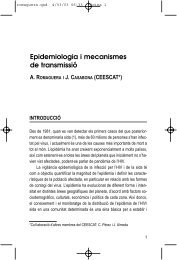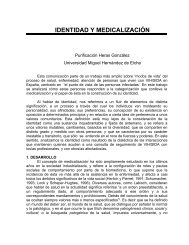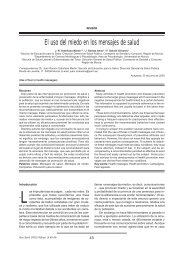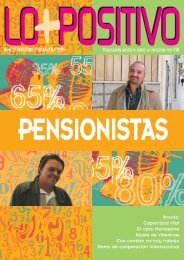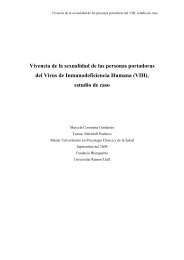HIV and injection drug use in Latin America - Sida Studi
HIV and injection drug use in Latin America - Sida Studi
HIV and injection drug use in Latin America - Sida Studi
You also want an ePaper? Increase the reach of your titles
YUMPU automatically turns print PDFs into web optimized ePapers that Google loves.
<strong>HIV</strong> <strong>and</strong> <strong><strong>in</strong>jection</strong> <strong>drug</strong> <strong>use</strong> <strong>in</strong> Lat<strong>in</strong> <strong>America</strong> Rodríguez et al.S35of databases, National AIDS Programme (NAP) reports<strong>and</strong> published <strong>and</strong> grey literature sources. Key expertswith access to unpublished national data were consultedfor Argent<strong>in</strong>a, Brazil, Colombia <strong>and</strong> Mexico. A regionaloverview <strong>and</strong> <strong>in</strong>formation on selected countries will bediscussed.<strong>HIV</strong>/AIDS <strong>and</strong> <strong>drug</strong> <strong>use</strong> trendsAccord<strong>in</strong>g to UNAIDS, IDU is now a major form of<strong>HIV</strong> transmission worldwide. A total of 134 countriesreported documented cases of IDU <strong>in</strong> 1999, <strong>and</strong> 114 ofthem reported <strong>HIV</strong> <strong>in</strong>fection associated with IDU [1].As several studies conducted <strong>in</strong> Lat<strong>in</strong> <strong>America</strong> havefound, unprotected sex <strong>and</strong> <strong>drug</strong> <strong>use</strong>, with a risk of<strong>HIV</strong> transmission, is not conf<strong>in</strong>ed to IDU [2,3]. Theextent to which <strong><strong>in</strong>jection</strong> <strong>drug</strong> <strong>use</strong>rs <strong>and</strong> crack <strong>use</strong>rs,their sexual partners <strong>and</strong> offspr<strong>in</strong>g are affected by theepidemic <strong>in</strong> Lat<strong>in</strong> <strong>America</strong> varies <strong>in</strong> the differentregions <strong>and</strong> with<strong>in</strong> each country. Infection by IDUmakes up almost a third of the cases recorded <strong>in</strong>Argent<strong>in</strong>a, Chile, Paraguay <strong>and</strong> Uruguay [4]. In countriessuch as Paraguay <strong>and</strong> Bolivia, <strong>and</strong> <strong>in</strong> most of theCaribbean countries, the role of IDU is limited [2]. Incountries where <strong>in</strong>jected <strong>drug</strong>s are widely <strong>use</strong>d, such as<strong>in</strong> Argent<strong>in</strong>a <strong>and</strong> Brazil, there are different patterns ofthe epidemic.There are two superimposed trends <strong>in</strong> Lat<strong>in</strong> <strong>America</strong><strong>and</strong> the Caribbean: (i) The late 1990s explosion ofcrack <strong>use</strong> plays a key role <strong>in</strong> the regional <strong>HIV</strong>/AIDSepidemic, this can be observed <strong>in</strong> southeastern Brazil[5,6]; (ii) The recent <strong>in</strong>creased availability of opiumderivatives such as hero<strong>in</strong>, <strong>and</strong> the extent of its spread<strong>in</strong> Lat<strong>in</strong> <strong>America</strong>, has been the subject of debate,beca<strong>use</strong> its cultivation <strong>and</strong> sale is still a relatively recentdevelopment. Prelim<strong>in</strong>ary data show <strong>in</strong>creased consumption<strong>in</strong> different parts of Brazil [7]. In the Andeanarea <strong>and</strong> <strong>in</strong> Mexico its availability has <strong>in</strong>creased as aresult of new plant<strong>in</strong>gs, but for now its effect on localconsumption has been limited [8,9].IDU AIDS cases are driv<strong>in</strong>g the current epidemiologicaltrend <strong>in</strong> the Southern Cone countries at 34.3%,followed by Brazil at 20.2%. Meanwhile, <strong>in</strong> the Lat<strong>in</strong>Caribbean they represent 2.8%, Central <strong>America</strong> 0.9%,Mexico 0.6%, <strong>and</strong> the Andean area 0.2% [10]. Availabledata on IDU <strong>HIV</strong> prevalence are absent or scarce,with the exception of some studies <strong>in</strong> Argent<strong>in</strong>a <strong>and</strong>Brazil. Even with evidence of transmission marked byIDU AIDS cases, there is a notorious lack of studies <strong>in</strong>most other countries. In 1984–1998, only four out of21 Lat<strong>in</strong> <strong>America</strong>n countries reported prevalence <strong>in</strong> the<strong>HIV</strong>/AIDS Surveillance International Database [11], oron the UNAIDS EPI Fact Sheets [12] (see Table 1).Table 1. Injection <strong>drug</strong> <strong>use</strong> proportion of total AIDS cases.Country% of IDU AIDS casesArgent<strong>in</strong>a 41.9Belize 0Brazil 21.7Bolivia 3.5Chile 5Colombia 0.05Costa Rica 1.3Cuba 0Ecuador 0.6El Salvador 1.3GuatemalaSDHaitiSDHonduras 0.1Mexico 0.6Nicaragua 7.0Panama 2.5Paraguay11Peru 0.1Dom<strong>in</strong>ican Republic 3.5Uruguay26.3Venezuela 1.0IDU, Injection <strong>drug</strong> <strong>use</strong>.Sources: UNAIDS EPI Fact Sheets; <strong>HIV</strong>/AIDS Surveillance Database,June 2000.With regard to <strong>drug</strong> consumption, there is a grow<strong>in</strong>g<strong>and</strong> worrisome problem <strong>in</strong> all countries, although theextent of the problem varies <strong>in</strong> each one. In southernLat<strong>in</strong> <strong>America</strong>, for example, Chile <strong>and</strong> Paraguay haveless IDU than Argent<strong>in</strong>a, Brazil, <strong>and</strong> Uruguay. Nevertheless,all five countries are part of the South Americ<strong>and</strong>rug traffick<strong>in</strong>g route, a fact that might contributeto the spread of illicit <strong>drug</strong> <strong>use</strong> <strong>and</strong> an <strong>in</strong>creased risk ofassociation between <strong>in</strong>jected <strong>drug</strong>s <strong>and</strong> <strong>HIV</strong>.The geographical position of the five countries, whichshare long borders with heavy movement of people, isanother factor contribut<strong>in</strong>g to the spread of <strong>HIV</strong> [13].Coca<strong>in</strong>e is the ma<strong>in</strong> <strong>in</strong>jected <strong>drug</strong> <strong>use</strong>d <strong>in</strong> thesecountries. Other <strong>in</strong>jected substances <strong>in</strong>clude amphetam<strong>in</strong>es,code<strong>in</strong>e-based cough syrups <strong>and</strong> alcohol [14].Argent<strong>in</strong>aCoca<strong>in</strong>e <strong>use</strong> has been <strong>in</strong>creas<strong>in</strong>g <strong>in</strong> Argent<strong>in</strong>a dur<strong>in</strong>gthe past 15 years. Inhalation is the most popular formof self-adm<strong>in</strong>istration. There is also evidence of the<strong>in</strong>creas<strong>in</strong>g <strong>use</strong> of coca paste <strong>and</strong> crack coca<strong>in</strong>e <strong>in</strong>Buenos Aires [15].A national study <strong>in</strong> 1999 established that 2.9% of thepopulation between 16 <strong>and</strong> 64 years of age had <strong>use</strong>dillegal <strong>drug</strong>s <strong>in</strong> the previous month; 3.6% had a lifelong<strong>use</strong> of coca<strong>in</strong>e, <strong>and</strong> 9.6% of coca<strong>in</strong>e <strong>use</strong>rs <strong>in</strong>jected it[16]. On the basis of these data, the number of coca<strong>in</strong>e<strong>in</strong>jectors has been estimated at 50,000 men <strong>and</strong> 14,500women [17].In 1985, the first IDU AIDS case was reported. Theproportion of IDU AIDS cases makes up 41.9% of the


